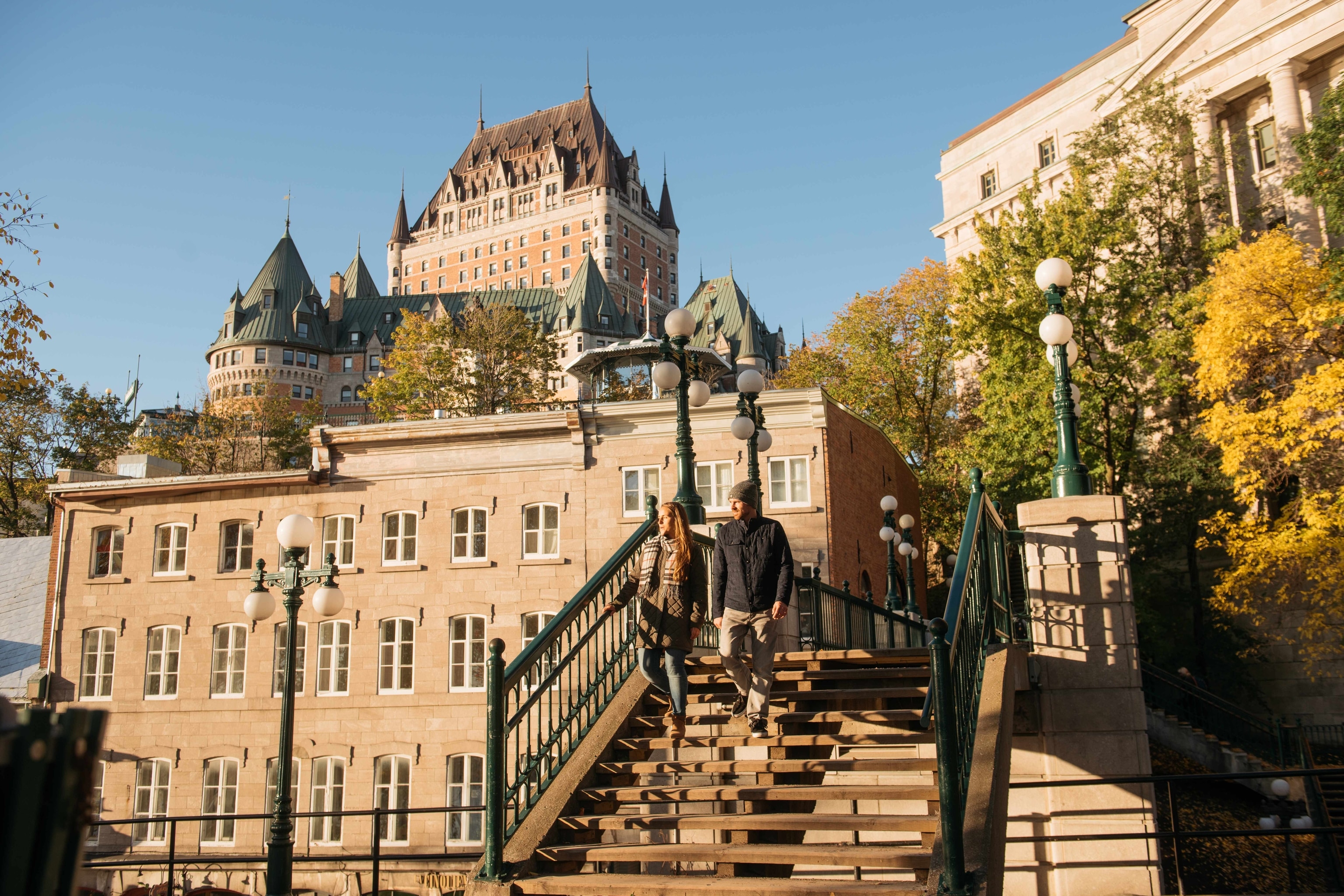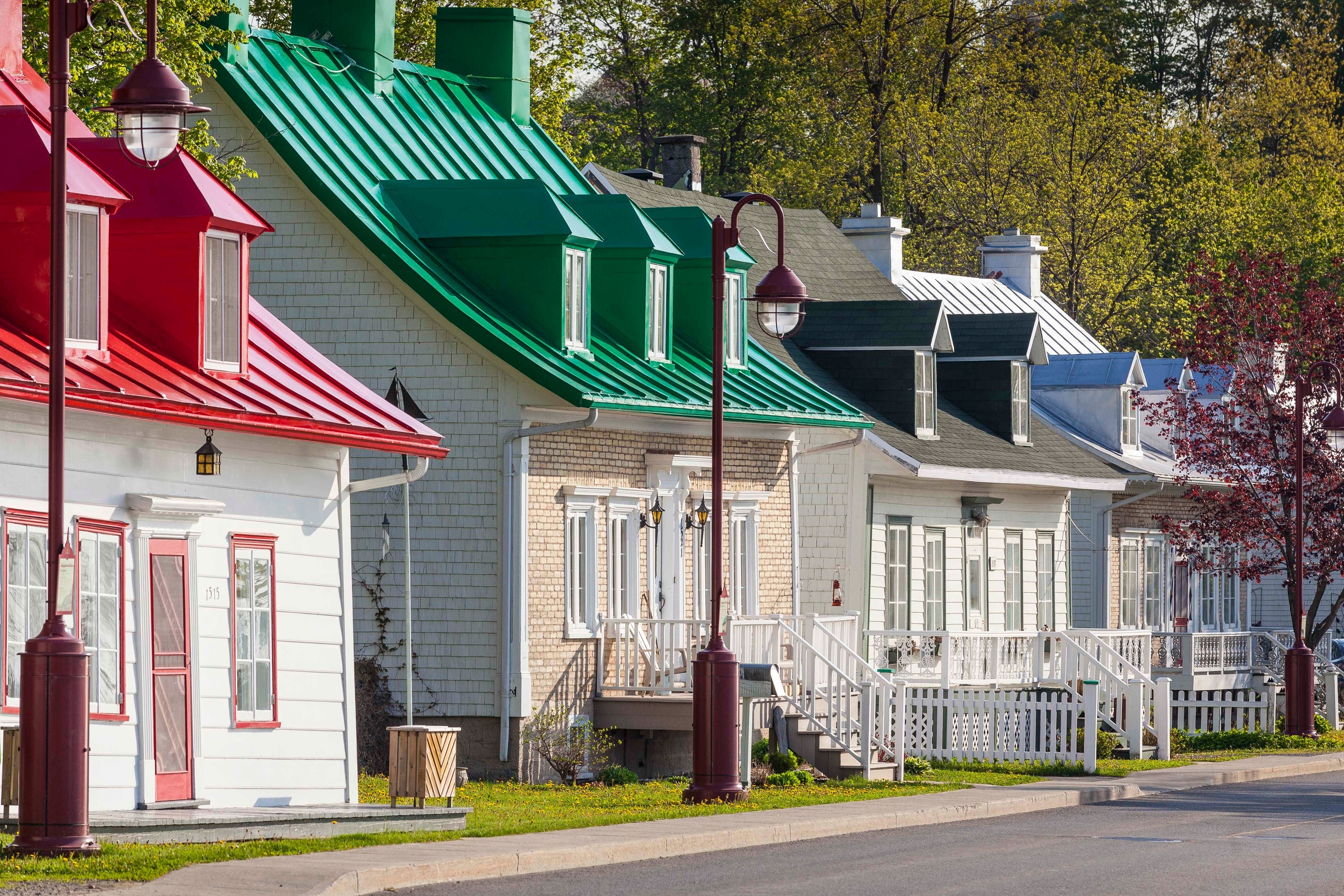
A Local’s Guide to Three Days in Québec City
When time is short, this historic Canadian destination satisfies every craving.
Imaginative, modern and forward-thinking, aren’t normally words you’d associate with a place that is more than 400 years old, but they are the perfect description of today’s Québec City. Ask a local for their favorite spots and they’ll share a list as familiar as it is surprising. Iconic must-sees make the list but so do places only an insider would know to look for…until now. On this jam-packed three-day itinerary, here are some of the best ways to enjoy the new Québec City.


DAY ONE
History and Art
Wake up in a castle in the sky. Perched high above the city, the Fairmont Le Château Frontenac is the iconic centerpiece of the UNESCO World Heritage neighborhood of Old Québec. The hotel has spent more than 125 years at the service of high-profile guests who range from Charles Lindbergh to Celine Dion. Newly renovated, its classic exterior now boasts an upgraded interior décor, complete with marble bathrooms and Art Deco touches. Want to sleep like a world leader? Suites like the Roosevelt and the Churchill celebrate famous leaders who have been guests at the illustrious hotel. Even if you aren’t staying here, breakfast at the Place Dufferin restaurant, especially if it includes their signature maple-wood smoked bacon, is worth popping in for.
Right outside your door, and just past the sky-high statue of Samuel de Champlain, you’ll spot the entrance to the Old Québec Funicular. The cable car which runs on a track has been taking breakfast-heavy passengers between Upper and Lower Town since 1879.




The cobblestone streets and acute angled hills in Lower Town will quickly let you know if you made a sensible footwear choice. Head for Place Royale, the place where Samuel de Champlain first called home, but take your time getting there. Wandering between the stone buildings that have stood here since the 1700s is time well spent.
Eventually, head towards the water. Québec’s Old Port area is beautiful by day or night. Bike rentals along the route make it easy to join the countless others making their way along the waterfront path. Prefer to stay on foot? Rue Saint-Pierre offers the charms of local shopkeepers, historic homes and waterfront art sculptures, and plenty to see on route to the Musée de la civilisation where interactive exhibits explore modern themes.

Ready for lunch? Options abound. Choose the waterfront views at nearby Le Café du Monde or the boreal cuisine at La Légende where you’ll find a wealth of healthier options perfect for a picnic.
Refueled you’ll be ready to explore the area’s military history. To do so, you’ll need to go beyond the oldest fortified walls in North America. More than 400 years old, they mark the boundaries of Old Québec. On the other side you’ll find the 254-acre grounds of Battlefields Park that overlooks the mouth of the St. Lawrence River. Home to the star-shaped Citadelle of Québec and the Plains of Abraham, the site marks the 1759 battle between the French and British. From June to October, visit at nightfall to join notable figures from the Citadelle’s past recounting the tales of a long-ago era as you discover the site.


There are other ways to explore the history of this city. Head to Musée national des beaux-arts du Québec for fine art within the pavilions and outside gardens. Or opt for history from a different perspective on the Quebec History X Tours. Led by Québécois rapper Webster (whose given name is Aly Ndiaye), the tour explores Québec’s history through the lens of people of color who first came to the province in 1629 as slaves.
A setting sun is no reason to call it quits. The city only gets better at night. Consider dining on Grande Allée where sidewalk patios and street-facing restaurants have been a reason to pause since the 19th century. Pop in for a bite now or wander back later when the restaurant scene switches over to live music and nightclubs. After dinner, stroll past National Assembly, the Parliament Building. Free guided tours of the building’s interior, designed in the Second Empire style and built between 1877 and 1886, are available, but you may need to save that for another visit. You can’t miss the intricate Fontaine de Tourny out front—a gift from Quebec’s iconic Simons store to celebrate the city’s 400th anniversary in 2008.


Looking for a nightcap? Head back to the hotel and slip into a seat at Bar 1608 where mixologists are at the ready with inventive cocktails. A quick walk through the halls, laden with historical photos and artifacts, is the perfect lead-in to dreams of what day two will bring.
Local Tip: Walk along the Dufferin Terrace for an integral understanding of the city's history. The boardwalk was completed more than 100 years ago. Discover the cannons that line the waterfront as a nostalgic display to the protection they once provided the city.
DAY TWO
Exploring Québec City’s Rural side
Pop out of the hotel, head through the park Place d’Armes and down Rue du Trésor, making a mental note to pop back later when the artists will be out painting and the gas lights turned on. Grab breakfast at Café La Maison Smith before heading over to see the Notre-Dame de Québec Basilica-Cathedral in the morning light.


When you’re ready, rent a car for an easy 10-minute drive to the 272-foot tall Montmorency Falls. Ride the cable car to the top before heading out across a stunning suspension bridge over to Île d’Orléans. On island, make your first stop Cassis Monna & Filles. The Monna family’s connection with cassis dates back to the 1800s in France. Today, Anne Monna-Lamare and her sister Catherine are the fifth generation in the family business. Their signature cassis and vanilla soft serve packs a flavorful punch. When you’re done here the rest of the island awaits. Among the must-stops: La Roulotte du Coin for foie gras-topped duck burgers; Tigidou for homemade jams and dark maple syrup; La Boulange for fresh baked chocolate bread.
Before heading off the island be sure to stop for a picture at the unique sculpture of the much-loved French-Canadian poet and singer-songwriter Félix Leclerc.


Back on the mainland, stay on the highway and head west towards Anse du Cap-Rouge. Celebrate going further afield than most tourists usually do with an outstanding tuna tartare and glass of wine at Quai 1635 overlooking a quiet, marsh-like landscape. Walk the waterfront, peeking at the beautiful homes along the path, before heading back to Old Québec.
Street performers are legendary in Québec City. Save time to catch a show in one of the public squares by keeping dinner simple. The Québécois classic of French fries, cheese curds and gravy is offered up at spots that range from local fast food giant Chez Ashton to chic hotel restaurant offerings that offer inventive culinary twists. At Le Chic Shack you can add a boozy milkshake, including Kahlua and Whisky options, to your meal.






Take in the skyline at sunset from aboard the Québec-Lévis ferry. The ten-minute journey to Lévis offers spectacular views of Québec City and costs only a few dollars each way.
Still not ready to turn in? Take an early evening stroll along the Promenade des Gouverneurs just below your hotel and explore the neighborhood shops in lamp-lit Quartier Petit Champlain.

Local Tip: Local outdoor enthusiast Gabriel Gakwaya suggests trading four wheels for two when you’re in the city. Guided biking trips around the Montmorency falls or simpler cycles along the Samuel-De Champlain Promenade. There are bike kiosks throughout the city that rent on an hourly or daily basis.
DAY THREE
Trendy Neighborhoods and Shopping Escapades
Wake up early to walk the fortified walls for a view of both the old and the new. Instead of hanging inside the old city, today you’ll explore the trendy neighborhoods that have developed just outside it: Saint-Jean-Baptiste and Saint-Roch district. The streets are a mix of creative locals who’ve set up shops in these vibrant areas. Wander and window shop. You may want to peruse the vinyl at Le Knock-Out record shop right away or make plans to return in the afternoon to play the retro pinball machines and video games at MacFly Bar Arcade.



For lunch pop into Nina Pizza– the crowdfunded local favorite offers full pies to eat in or take away. Or stop in at Deux 22: From the outside it looks like a clothing shop but inside you’ll find a tequila bar, Mexican food eatery and patio.
In the afternoon stray even further afield. Hop a cab over to Limoilou. The diverse neighborhood is a mix of new immigrants, budding entrepreneurs and young families. Popular muralist Marie-Claude Grou, a.k.a. “MC Grou” grew up here. One of her first murals, (heart Limoilou) is the perfect spot to snap an Instagram photo. Right next door, Article 721 is touted as one of the best places to score local designer fashions and wares. Continue on to “bra terrace”, where donated brassieres form a patio canopy outside Soupe & Cie and consider leaving something in the community fridge for locals who are down on their luck.


If you’ve reserved 2-3 months in advance, dinner tonight could be at one of the best restaurants in the country. Battuto, a tiny Italian eatery on the must-dine list of locals and visitors alike. On a budget? Consider making a meal out of the Bureau de Poste’s famous tapas menus. Or opt for a farm-to-table offering at Le Clocher Penché, or pop into Chez Muffy for something richer.
Choose a different route home to the old city when you’re done. Consider it a bonus if you make your way past the Maison de la Litterature – a local library set inside the former Wesley church – where you can take one last gasp at the marvels of Québécois ingenuity.
Local Tip: For shopping, try Coeur de Loup for made to measure items or, as entrepreneur Anna Monna-Lamare suggests, Jupon Pressé for off the rack options. And try starting any shopping trip with a freshly made donut (including vegan options) at Café Saint-Henri, in Saint-Roch.

Heather Greenwood Davis is a frequent contributor to National Geographic Travel and a local Toronto writer who also loves her city. You can follow her travels on Twitter.






